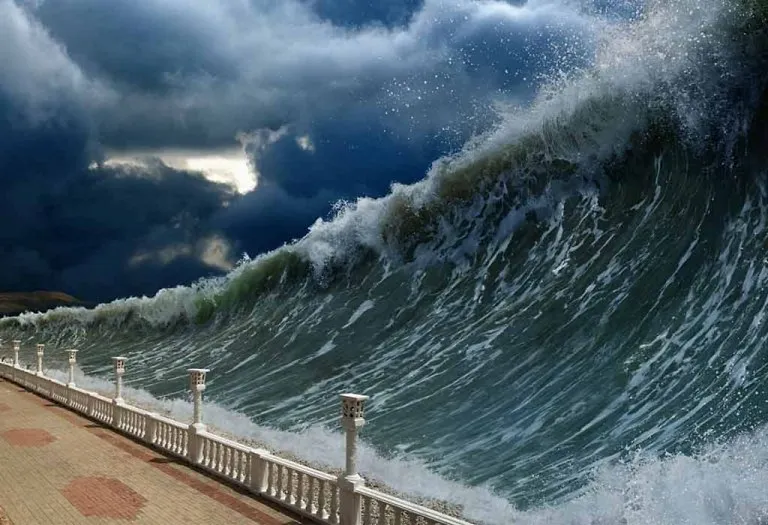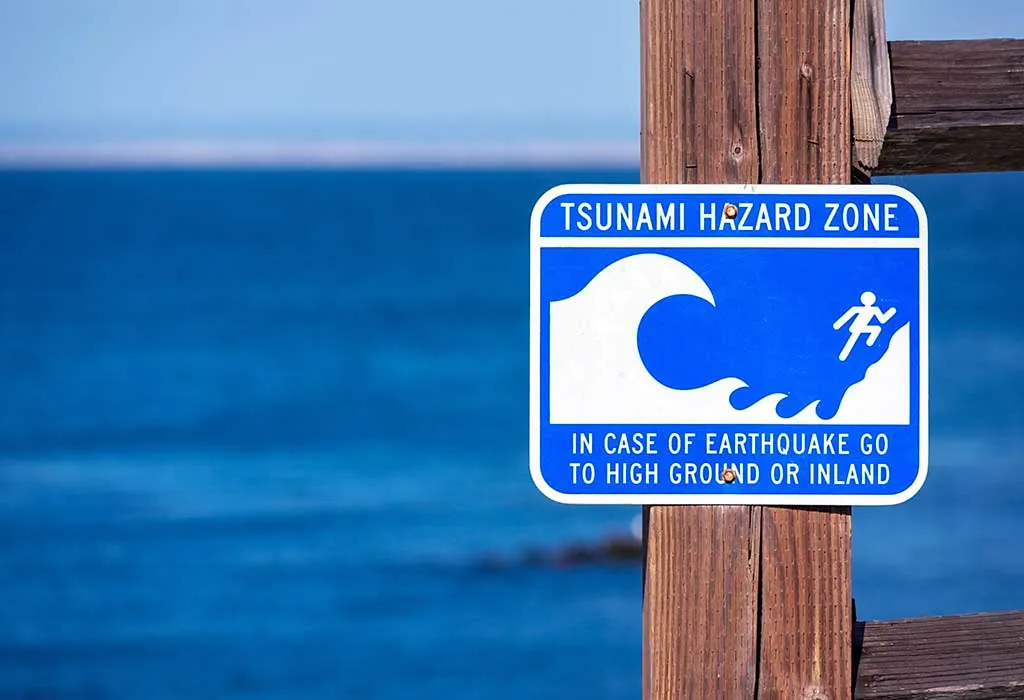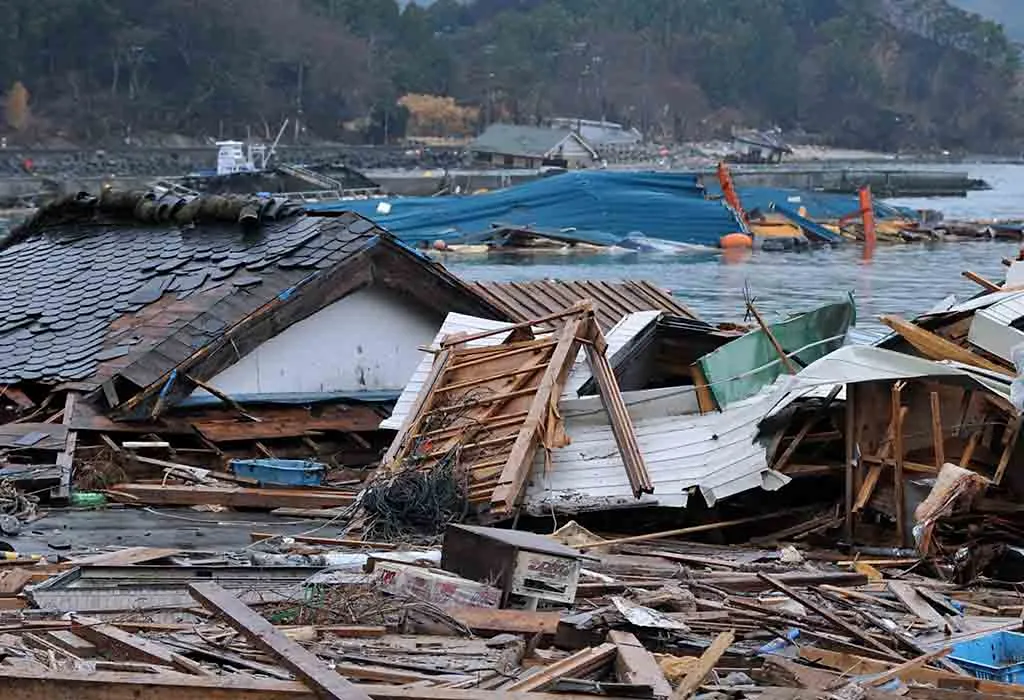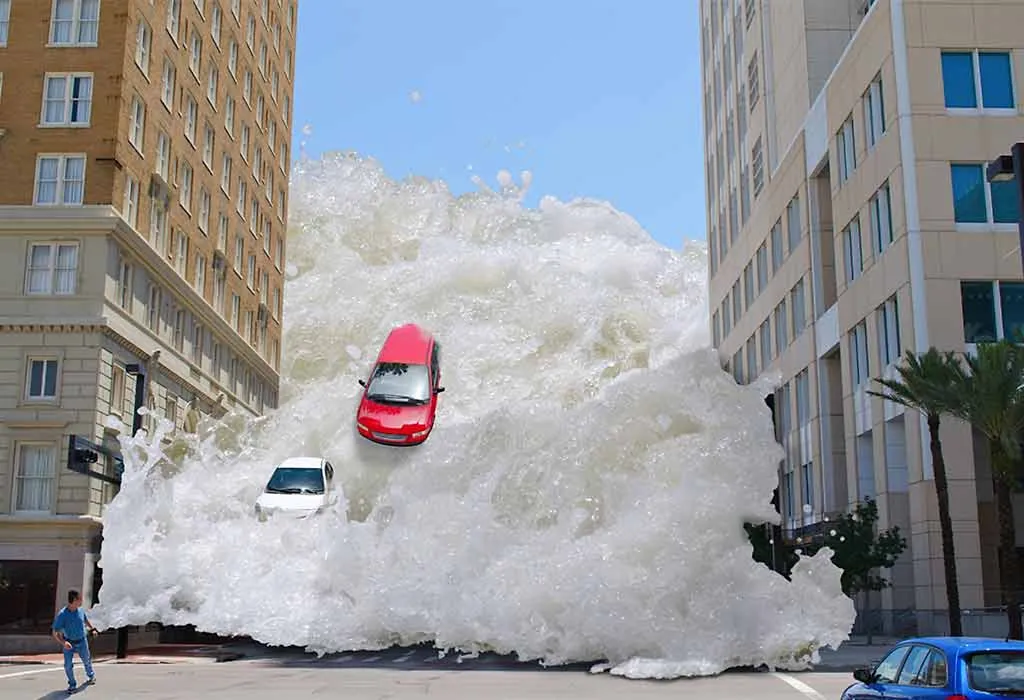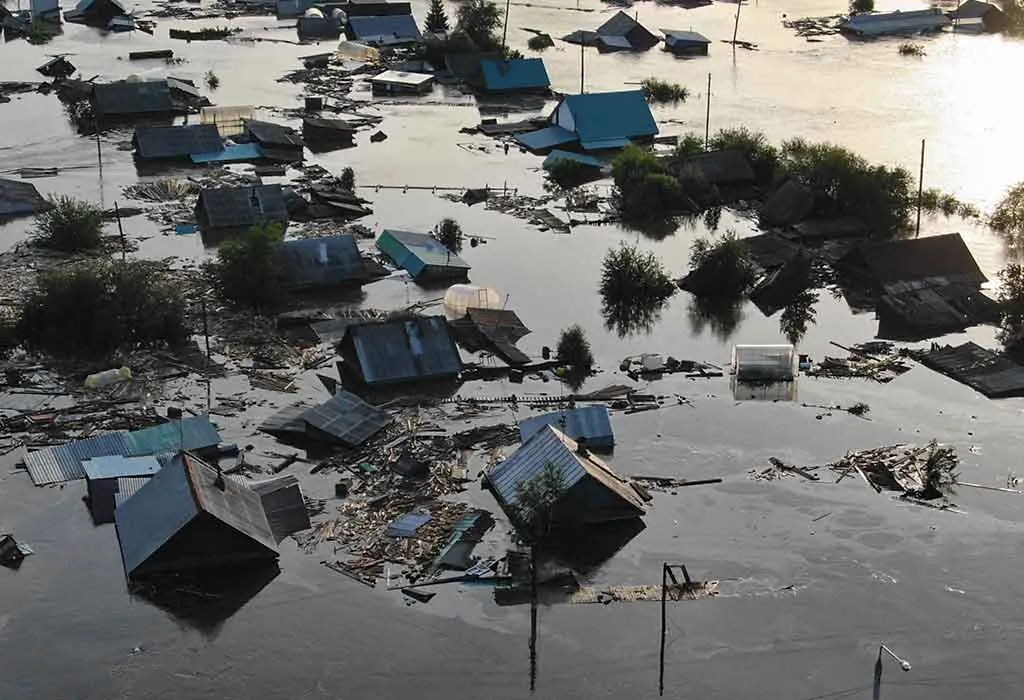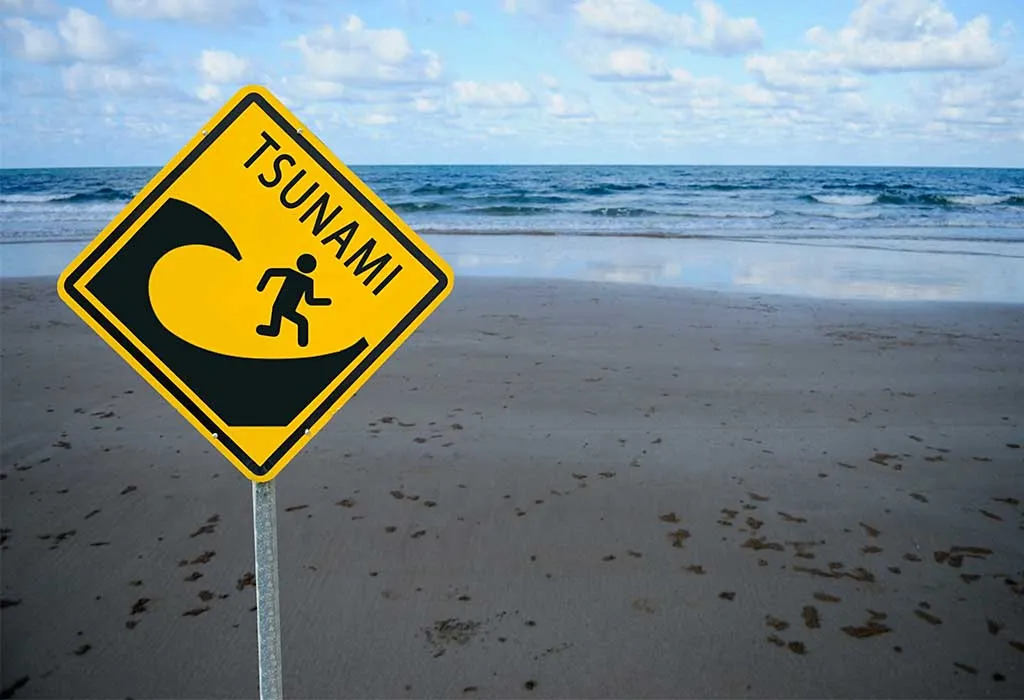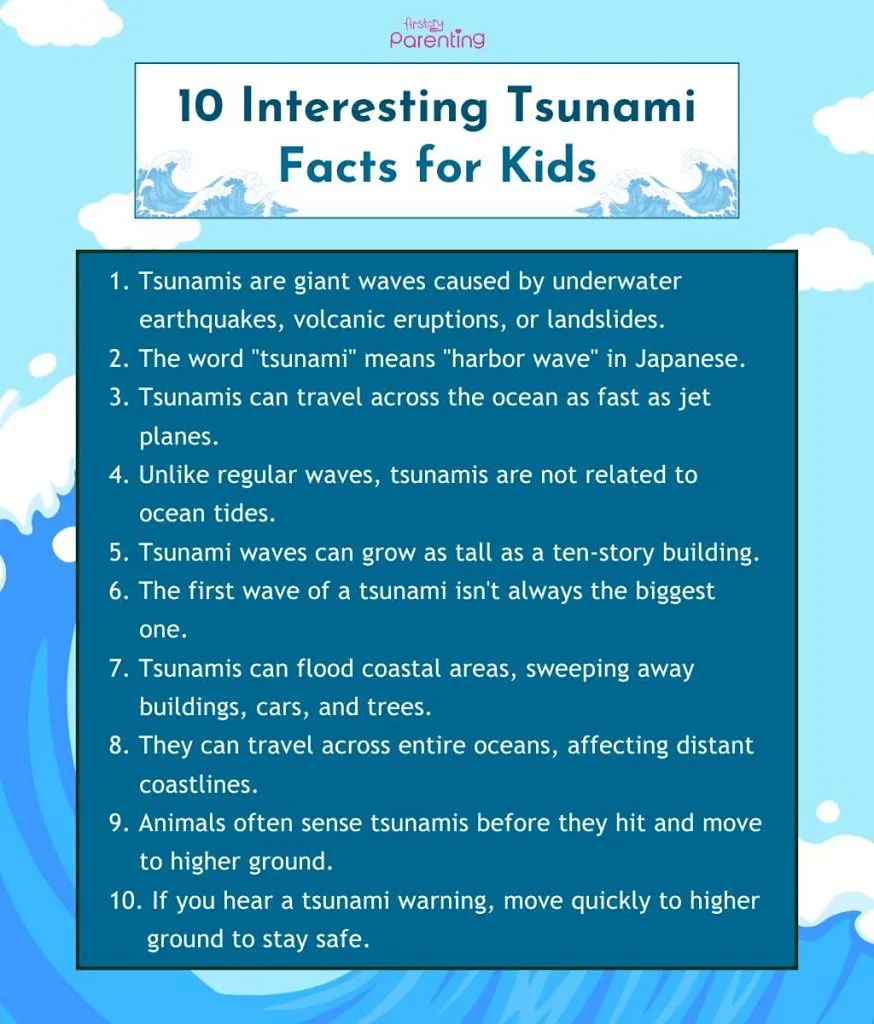Amazing Tsunami Facts For Kids
Hey there, young explorers! Are you ready to dive into the world of tsunamis? Tsunamis are one of nature’s most awe-inspiring phenomena, and there’s so much to learn about them. In this article, we’re going to explore some amazing tsunami facts that are both fun and interesting, especially for kids like you. Tsunamis might sound a bit scary, but they’re also fascinating – much like a mystery story where the ocean is the main character. Get ready for an exhilarating exploration into the mysteries of tsunamis, where we’ll learn about these enormous waves, their journey across the sea, and their impact on our world. Remember, learning about nature helps us protect our planet, and that makes you a superhero in your own way! Let’s get started with these fun and interesting facts about tsunami for kids.
Interesting Facts About Tsunamis
Dive into the world of tsunamis with us! In this section, we’ll unravel some cool facts and key information about tsunamis. Prepare to be amazed as we reveal fun facts about tsunamis that will make you see these ocean giants in a whole new light.
What Is a Tsunami?
According to National Geographic, a tsunami consists of multiple ocean waves with very long lengths, often spanning hundreds of kilometres. These waves are triggered by major disturbances in the ocean, like earthquakes, volcanic eruptions, glacier calvings, or impacts from meteorites.
Are Tsunamis Dangerous?
Yes, tsunamis are extremely dangerous. They can cause catastrophic damage to coastlines, including severe flooding, destruction of infrastructure, and loss of life.
History of Tsunami
Tsunamis are one of nature’s most powerful and destructive forces, having shaped coastlines and impacted societies throughout history. Their occurrence, while infrequent compared to other natural disasters, has often been met with tragic consequences.
- Ancient Records: The oldest recorded tsunami dates back to 426 BC in the Greek historical texts, describing the destruction of Potidaea in Greece, believed to be caused by a tsunami resulting from an earthquake.
- Santorini Eruption (around 1600 BC): A notable ancient occurrence linked to a tsunami is the volcanic eruption on Santorini in the Aegean Sea. This event triggered enormous tsunamis and is believed to have contributed to the downfall of the Minoan civilization on Crete.
- 1755 Lisbon Earthquake: A notable tsunami in recorded history followed the 1755 Lisbon earthquake, which affected the coasts of Portugal, Spain, and North Africa and even reached as far as the Caribbean.
- Krakatoa Eruption (1883): The eruption of Krakatoa in Indonesia generated tsunamis that killed over 36,000 people, with waves that were reported to be as high as 40 meters (130 ft).
- 20th Century: The 20th century saw several significant tsunamis, including the 1946 Aleutian Islands tsunami and the 1960 Valdivia tsunami in Chile, which are among the most powerful earthquakes and tsunamis ever recorded.
- 2004 Indian Ocean Tsunami: One of the deadliest tsunamis in recent history occurred on December 26, 2004, triggered by a massive earthquake with a magnitude of 9.1–9.3 Mw off the coast of Sumatra, Indonesia (2). It rose to a height of 65 to 100 feet in Sumatra and claimed the lives of over 230,000 people across 14 countries, prompting a global humanitarian response (3).
- 2011 Tōhoku Earthquake and Tsunami: On March 11, 2011, a massive tsunami triggered by a 9.0 magnitude earthquake near Japan’s coast led to extensive destruction, including the Fukushima nuclear crisis, and prompted major enhancements in tsunami alert systems (4).
What Causes a Tsunami?
How Are Tsunamis Created?
According to the National Oceanic and Atmospheric Administration, a tsunami is caused by a series of sudden and large displacements of the earth’s ocean crust due to geological disturbances like an earthquake below or near the bed of the ocean. This force displaces the water body to create large waves that tend to radiate in all directions other than the point of force. This force could be so big that it has the potential to cross entire ocean basins. The large water waves travel towards the shore, and when they hit the shallow water, the water height increases and crushes into the coastline, ultimately creating havoc on the coastline.
How Do You Know if a Tsunami Is Coming?
Tsunami warnings are typically issued based on seismic activity, such as earthquakes that have the potential to generate a tsunami. Ocean buoys and tide gauges detect changes in sea level, which can indicate the approach of a tsunami wave. Additionally, a natural sign of an impending tsunami is a rapid and unexpected retreat of water from the coastline, exposing the sea floor.
How Can You Survive a Tsunami?
Surviving a tsunami involves prompt action and awareness of your surroundings, especially if you live in or are visiting a coastal area known for seismic activity. Understanding the natural signs and responding quickly to official warnings can save lives.
- Heed Warnings: Always pay attention to tsunami warnings from local authorities and be ready to evacuate immediately when advised.
- Know the Signs: Be alert to natural signs, such as an earthquake or a sudden drop in sea level, which can precede a tsunami.
- Evacuate Early: If you suspect a tsunami is coming, don’t wait for official instructions and move to higher ground as quickly as possible.
- Stay Informed: Keep a battery-powered radio to receive updates and instructions from emergency services.
- Avoid the Coast: Stay away from the beach and coastal areas until authorities declare it safe to return.
- Have a Plan: Create a family emergency plan that includes meeting points and contact information in case you are separated.
- Prepare an Emergency Kit: Keep an emergency kit with food, water, medications, and other essentials ready to grab and go.
- Practice Drills: If you live in a tsunami-prone area, participate in community evacuation drills to be better prepared.
- Stay on High Ground: Once you have evacuated to a safe place on high ground, remain there until official sources have confirmed that the threat is over.
What Is the Height of Tsunami Waves?
The height of tsunami waves, known as the amplitude, can vary significantly. In the open ocean, tsunami waves are typically only a few centimetres high but can travel at speeds exceeding 500 kilometres per hour. However, as they approach shallower coastal waters, they can grow in height dramatically, sometimes reaching 30 meters (about 100 feet) or more when they hit the shore (7).
What Is the Speed of Tsunami Waves?
According to the National Oceanic Atmospheric Administration; Tsunami waves vary in speed based on ocean depth. In deeper waters, they can move as fast as 500-800 km/h (310-500 mph), similar to a jet’s speed. Near coastlines, in shallower waters, their speed slows but can still reach up to 50 km/h (approximately 30 mph) upon reaching the shore.
Where Do Most Tsunamis Occur?
Most tsunamis occur in the Pacific Ocean’s ‘Ring of Fire,’ an area with high seismic activity from tectonic plate boundaries (8). The Ring of Fire encompasses the coasts of Asia, North America, South America, and Oceania, where tectonic movements frequently cause earthquakes and volcanic activity. However, tsunamis can also happen in any large body of water, including other oceans and the Mediterranean Sea, where geological conditions can trigger their formation.
What Does a Tsunami Look Like When It Strikes the Shoreline?
When a tsunami strikes the shoreline, it often does not appear as a breaking wave but rather as a rapidly rising and overwhelming surge of water that can flood the coast. The water can come ashore with tremendous force, carrying a mass of debris and causing destruction to anything in its path. Unlike normal surf waves, which last a few seconds, tsunami waves can last for minutes and can arrive in a series, with successive waves often being more powerful.
How Many Times a Year Do Tsunamis Occur?
On average, two tsunamis occur each year across the world that cause damage near the source. However, significantly destructive tsunamis that affect global coastlines are much less frequent, occurring about once every 15 years.
What Is the Main Difference Between a Tsunami and a Tidal Wave?
The main difference between a tsunami and a tidal wave lies in their causes and characteristics. A tsunami is primarily caused by underwater disturbances like earthquakes, volcanic eruptions, or landslides, leading to a series of waves with very long wavelengths and periods. On the other hand, a tidal wave originates from the gravitational pull exerted by the Earth, moon, and sun. This interaction causes the regular rise and fall of sea levels, known as tides, which are predictable and unrelated to seismic activity.
More Interesting Facts About Tsunamis for Kids
Tsunamis are fascinating natural phenomena that can teach us a lot about the Earth and its oceans. Here are some interesting facts about tsunamis, especially for kids:
- Not Just One Wave: A tsunami is not just a single wave but a series of waves, known as a wave train, and the first wave is not always the largest.
- Sound of Tsunamis: Some tsunamis can be heard as a roaring sound, similar to that of an approaching train or aeroplane.
- Animals Can Sense Tsunamis: Animals like elephants often sense a tsunami is coming before humans do (9). They may act strangely or move to higher ground.
- Tsunamis in Lakes: Tsunamis can occur in large lakes as well, following a large landslide or seismic activity in the area.
- Ancient Tsunamis on Mars: Scientists believe that ancient tsunamis may have occurred on Mars, suggesting the presence of large bodies of water in the planet’s past.
- Speed Depends on Water Depth: The speed of a tsunami wave depends on the depth of the ocean. In deep water, they can travel as fast as a jet plane.
- Energy Travel: A tsunami’s energy can travel across entire ocean basins. The 2004 Indian Ocean tsunami affected coastlines as far away as Africa.
- Not Like Surfing Waves: Unlike regular surfing waves, which are caused by wind, tsunamis are caused by underwater geological activity.
- Can Cross Entire Oceans: Tsunamis can travel across entire oceans without losing much energy. The 2011 Japan tsunami reached the West Coast of the United States.
- Small in Open Ocean: In the open ocean, tsunami waves might only be a few centimetres high and go unnoticed by ships.
- Harbor Waves: The word “tsunami” comes from the Japanese words ‘tsu’ (harbor) and ‘nami’ (wave), because fishermen would return to find their harbor destroyed by a wave they didn’t see at sea (5).
- Underwater Landslides: Underwater landslides, which can be triggered by earthquakes, can also cause tsunamis.
- Long-lasting Impact: The aftereffects of a tsunami can last for years, including rebuilding destroyed communities and restoring ecosystems.
- Warning Systems: After the 2004 Indian Ocean tsunami, more countries installed tsunami warning systems to help save lives in future events.
Infographic
Tsunamis are awe-inspiring yet potentially devastating natural events that demonstrate the immense power of Earth’s geological processes. Understanding tsunamis, their causes, and their effects is crucial for promoting safety and preparedness in coastal communities around the world. As we further our understanding and respect for these powerful ocean waves, we grow to appreciate our planet’s dynamic character and strive to reduce their effects on human communities.
References/Resources:
1. Tsunamis; National Geographic; https://www.nationalgeographic.com/environment/article/tsunamis
2. Pacific Coastal and Marine Science Center; Tsunami Generation from the 2004 M=9.1 Sumatra-Andaman Earthquake; USGS; https://www.usgs.gov/centers/pcmsc/science/tsunami-generation-2004-m91-sumatra-andaman-earthquake; October 2018
3. Water Science School; Tsunamis and Tsunami Hazards; USGS; https://www.usgs.gov/special-topics/water-science-school/science/tsunamis-and-tsunami-hazards; June 2018
4. Great Tohoku, Japan Earthquake and Tsunami, 11 March 2011; NOAA; https://www.ngdc.noaa.gov/hazard/11mar2011.html
5. Tsunamis; Ready Kids; https://www.ready.gov/kids/disaster-facts/tsunamis
6. Tsunamis; National Oceanic and Atmospheric Administration; https://www.noaa.gov/education/resource-collections/ocean-coasts/tsunamis#:~:text=A%20tsunami%20is%20a%20series,sometimes%20crossing%20entire%20ocean%20basins.
7. Tsunami Frequently Asked Questions; National Oceanic and Atmospheric Administration; https://www.tsunami.gov/?page=tsunamiFAQ
8. Tsunami Forecasting; NOAA; https://celebrating200years.noaa.gov/magazine/dart_buoys/ring_of_fire.html
9. Can Elephants Sense Tsunamis Before they Happen?; Science On a Sphere; https://sos.noaa.gov/education/phenomenon-based-learning/can-elephants-sense-tsunamis/
Also Read:
Interesting Plant Facts for Kids
Amazing Facts About Science for Children
Information & Facts About Earthquakes for Kids
Was This Article Helpful?
Parenting is a huge responsibility, for you as a caregiver, but also for us as a parenting content platform. We understand that and take our responsibility of creating credible content seriously. FirstCry Parenting articles are written and published only after extensive research using factually sound references to deliver quality content that is accurate, validated by experts, and completely reliable. To understand how we go about creating content that is credible, read our editorial policy here.





